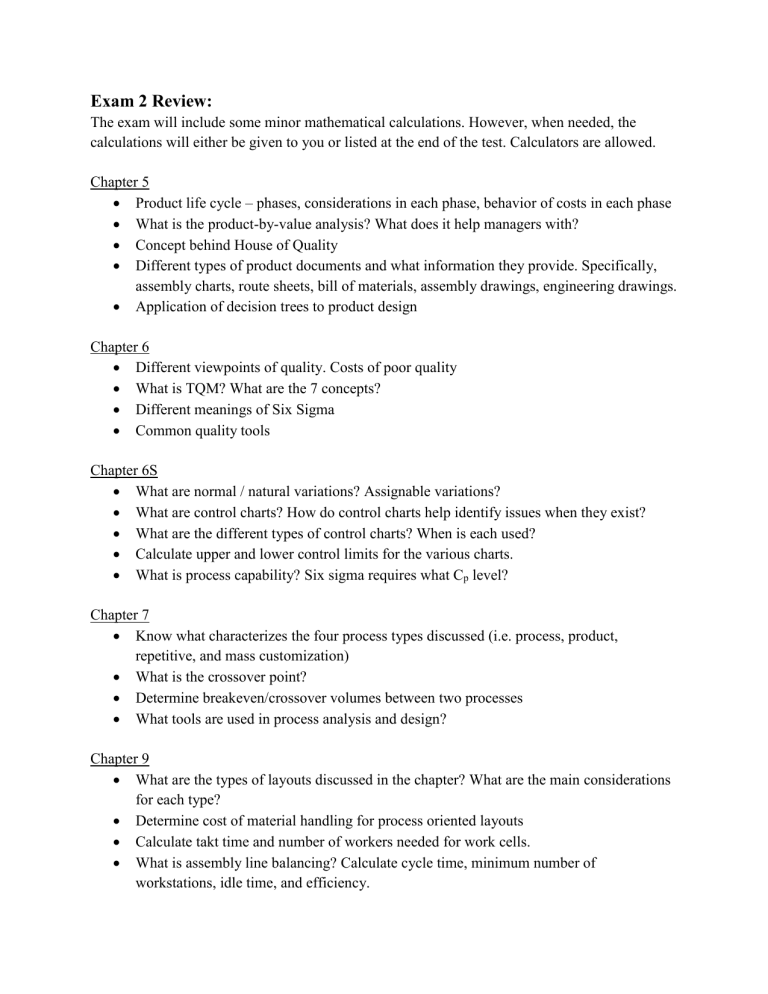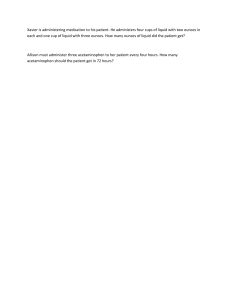
Exam 2 Review:
The exam will include some minor mathematical calculations. However, when needed, the
calculations will either be given to you or listed at the end of the test. Calculators are allowed.
Chapter 5
Product life cycle – phases, considerations in each phase, behavior of costs in each phase
What is the product-by-value analysis? What does it help managers with?
Concept behind House of Quality
Different types of product documents and what information they provide. Specifically,
assembly charts, route sheets, bill of materials, assembly drawings, engineering drawings.
Application of decision trees to product design
Chapter 6
Different viewpoints of quality. Costs of poor quality
What is TQM? What are the 7 concepts?
Different meanings of Six Sigma
Common quality tools
Chapter 6S
What are normal / natural variations? Assignable variations?
What are control charts? How do control charts help identify issues when they exist?
What are the different types of control charts? When is each used?
Calculate upper and lower control limits for the various charts.
What is process capability? Six sigma requires what Cp level?
Chapter 7
Know what characterizes the four process types discussed (i.e. process, product,
repetitive, and mass customization)
What is the crossover point?
Determine breakeven/crossover volumes between two processes
What tools are used in process analysis and design?
Chapter 9
What are the types of layouts discussed in the chapter? What are the main considerations
for each type?
Determine cost of material handling for process oriented layouts
Calculate takt time and number of workers needed for work cells.
What is assembly line balancing? Calculate cycle time, minimum number of
workstations, idle time, and efficiency.
Sample Questions:
1. High fixed costs and low variable costs are typical of which approach?
a. product
b. Process
c. mass customization
d. repetitive
e. A and C
2. Which of the following products is likely to be assembled on a repetitive process line?
a. Automobiles
b. custom personal computers
c. custom cakes
d. steel
e. beer
3. Process X has fixed costs of $10,000 and variable costs of $2.40 per unit. Process Y has
fixed costs of $9,000 and variable costs of $2.25 per unit. Which of the following
statements is TRUE?
a. The crossover point is approximately 6667 units.
b. It is impossible for one process to have both of its costs lower than those of
another process.
c. Process Y is cheaper than process X at all volumes.
d. Process X should be selected for very large production volumes.
e. Process X is more profitable than process Y and should be selected.
4. Service blueprinting:
a. provides the basis to negotiate prices with suppliers.
b. mimics the way people communicate.
c. determines the best time for each step in the process.
d. focuses on the provider's interaction with the customer.
e. uses the schematic of a house to diagram a service process.
5. Which of the statements below best describes office layout?
a. positions workers, their equipment, and spaces/offices to provide for movement of
information
b. addresses the layout requirements of large, bulky projects such as ships and
buildings
c. seeks the best personnel and machine utilization in repetitive or continuous
production
d. allocates shelf space and responds to customer behavior
e. deals with low-volume, high-variety production
Brandon's computer shop has hired a consultant to help apply operations management
techniques to increase profits. Currently the shop sells most of its computers to a highend customized online retailer and sales are steady at 250 per month. A single work cell
produces the computers. To produce the computer, three operations are required. First the
parts must be assembled, next software must be installed, and finally the computer must
be safely packed and labeled for shipping. These operations take 2 hours, 5 hours, and 1
hour respectively. If there are 6 available work hours each day and the shop operates 20
days per month:
6. What is the takt time?
a. 31.25 minutes
b. 28.8 minutes
c. 1.83 minutes
d. 41.67 minutes
e. 12.5 minutes
7. How many workers Brandon should hire?
a. 16 workers
b. 14 workers
c. 10 workers
d. 17 workers
e. 19 workers
8. An assembly line consists of 158 tasks grouped into 32 workstations. The sum of all task
times is 105 minutes. The largest assigned cycle time is 4 minutes. What is the efficiency
of this line?
a. 8 percent
b. 21 percent
c. 82 percent
d. 100 percent
e. 81 percent
9. Three broad categories of definitions of quality are:
a. product quality, service quality, and organizational quality.
b. user based, manufacturing based, and product based.
c. internal, external, and prevention.
d. low-cost, response, and differentiation.
e. Pareto, Shewhart, and Deming.
10. Among the tools of TQM, the tool ordinarily used to aid in understanding the sequence of
events through which a product travels is a:
a. Pareto chart.
b. flowchart.
c. check sheet.
d. Taguchi map.
e. poka-yoke.
11. If = 23 ounces, σ = 0.4 ounces, and n = 16, what will be the ±3σ control limits for the xbar chart?
a. 21.8 to 24.2 ounces
b. 23 ounces
c. 22.70 to 23.30 ounces
d. 22.25 to 23.75 ounces
e. 22.90 to 23.10 ounces
12. A manufacturer uses statistical process control to control the quality of the firm's
products. Samples of 50 of Product A are taken, and a defective/acceptable decision is
made on each unit sampled. For Product B, the number of flaws per unit is counted. What
type(s) of control charts should be used?
a. p-charts for both A and B
b. p-chart for A, c-chart for B
c. c-charts for both A and B
d. p-chart for A, mean and range charts for B
e. c-chart for A, mean and range charts for B
Formula Sheet:
X-Chart
R-Chart
X=μ
UCLR = D4R
σx = σ / √n
LCLR = D3R
takt =
Work time available / Units
required
# Workers =
C-Chart
Total operation time / takt
time
UCLx = X + zσx
LCLx = X - zσx
c = mean # of defects
X-Chart
UCLC = c + 3√c
UCLx = X + A2R
LCLC = c - 3√c
LCLx = X - A2R
P-Chart
σp = √[p(1 - p) / n]
UCLp = p + zσp
LCLp = p - zσp
Minimize costs:
n
n
X C
ij ij
i 1 j 1
Cycle time =
Production time / units
required
Process Capability
Cp = (UCL - LCL) / 6σ
Minimum workstations =
Σ task time / Cycle time
Cpk = minimum of:
{(UCL - x)/3σ} ;
{(x - LCL)/3σ}
Efficiency =
Σ task time / (Actual #
workstations x Largest cycle
time)
Idle time =
(Actual # workstations x
largest cycle time) - Σ task
time
Answers to Sample Questions:
1. E
2. A
3. C
4. D
5. A
6. B
7. D
8. C
9. B
10. B
11. C
12. B




